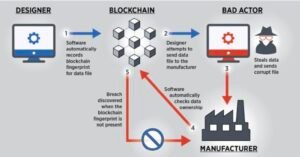ब्लॉकचेन कैसे काम करता है?
हालाँकि ब्लॉकचेन के अंतर्निहित तंत्र जटिल हैं, फिर भी हम निम्नलिखित चरणों में एक संक्षिप्त अवलोकन देते हैं। ब्लॉकचेन सॉफ़्टवेयर इनमें से अधिकांश चरणों को स्वचालित कर सकता है:
चरण 1 – लेनदेन रिकॉर्ड करें।
ब्लॉकचेन लेनदेन ब्लॉकचेन नेटवर्क में एक पक्ष से दूसरे पक्ष तक भौतिक या डिजिटल परिसंपत्तियों की आवाजाही को दर्शाता है। इसे डेटा ब्लॉक के रूप में रिकॉर्ड किया जाता है और इसमें निम्नलिखित विवरण शामिल हो सकते हैं:
इस लेन-देन में कौन शामिल था?
लेन-देन के दौरान क्या हुआ?
लेन-देन कब हुआ?
लेन-देन कहां हुआ?
यह लेन-देन क्यों हुआ?
कितनी परिसंपत्ति का आदान-प्रदान किया गया?
लेन-देन के दौरान कितनी पूर्व शर्तें पूरी की गईं?
चरण 2 – आम सहमति प्राप्त करें।
वितरित ब्लॉकचेन नेटवर्क पर अधिकांश प्रतिभागियों को इस बात पर सहमत होना चाहिए कि रिकॉर्ड किया गया लेनदेन वैध है। नेटवर्क के प्रकार के आधार पर, समझौते के नियम अलग-अलग हो सकते हैं लेकिन आमतौर पर नेटवर्क की शुरुआत में ही स्थापित किए जाते हैं।
चरण 3 – ब्लॉकों को लिंक करें।
एक बार जब प्रतिभागी सहमति पर पहुँच जाते हैं, तो ब्लॉकचेन पर लेन-देन को एक खाता बही के पन्नों के बराबर ब्लॉक में लिखा जाता है। लेन-देन के साथ, एक क्रिप्टोग्राफ़िक हैश भी नए ब्लॉक में जोड़ा जाता है। हैश एक श्रृंखला के रूप में कार्य करता है जो ब्लॉक को एक साथ जोड़ता है। यदि ब्लॉक की सामग्री को जानबूझकर या अनजाने में संशोधित किया जाता है, तो हैश मान बदल जाता है, जिससे डेटा से छेड़छाड़ का पता लगाने का एक तरीका मिलता है।
इस प्रकार, ब्लॉक और चेन सुरक्षित रूप से जुड़ते हैं, और आप उन्हें संपादित नहीं कर सकते। प्रत्येक अतिरिक्त ब्लॉक पिछले ब्लॉक और इसलिए पूरे ब्लॉकचेन के सत्यापन को मजबूत करता है। यह टावर बनाने के लिए लकड़ी के ब्लॉक को ढेर करने जैसा है। आप केवल ब्लॉक को ऊपर रख सकते हैं, और यदि आप टावर के बीच से एक ब्लॉक हटाते हैं, तो पूरा टावर टूट जाता है।
चरण 4 – खाता साझा करें।
यह प्रणाली सभी प्रतिभागियों को केंद्रीय खाता बही की नवीनतम प्रति वितरित करती है।
ब्लॉकचेन नेटवर्क के प्रकार क्या हैं?
ब्लॉकचेन में विकेन्द्रीकृत या वितरित नेटवर्क के चार मुख्य प्रकार हैं:
1–सार्वजनिक ब्लॉकचेन नेटवर्क।
सार्वजनिक ब्लॉकचेन बिना अनुमति के होते हैं और सभी को उनसे जुड़ने की अनुमति देते हैं। ब्लॉकचेन के सभी सदस्यों को ब्लॉकचेन को पढ़ने, संपादित करने और मान्य करने का समान अधिकार है। लोग मुख्य रूप से बिटकॉइन, एथेरियम और लिटकोइन जैसी क्रिप्टोकरेंसी का आदान-प्रदान और खनन करने के लिए सार्वजनिक ब्लॉकचेन का उपयोग करते हैं।
2–निजी ब्लॉकचेन नेटवर्क।
एक ही संगठन निजी ब्लॉकचेन को नियंत्रित करता है, जिसे प्रबंधित ब्लॉकचेन भी कहा जाता है। प्राधिकरण यह निर्धारित करता है कि कौन सदस्य हो सकता है और नेटवर्क में उनके पास क्या अधिकार हैं। निजी ब्लॉकचेन केवल आंशिक रूप से विकेंद्रीकृत होते हैं क्योंकि उन पर पहुँच प्रतिबंध होते हैं। व्यवसायों के लिए एक डिजिटल मुद्रा विनिमय नेटवर्क, रिपल, एक निजी ब्लॉकचेन का एक उदाहरण है।
3–हाइब्रिड ब्लॉकचेन नेटवर्क।
हाइब्रिड ब्लॉकचेन निजी और सार्वजनिक दोनों नेटवर्क के तत्वों को मिलाते हैं। कंपनियाँ सार्वजनिक प्रणाली के साथ-साथ निजी, अनुमति-आधारित सिस्टम स्थापित कर सकती हैं। इस तरह, वे ब्लॉकचेन में संग्रहीत विशिष्ट डेटा तक पहुँच को नियंत्रित करते हैं जबकि बाकी डेटा को सार्वजनिक रखते हैं। वे सार्वजनिक सदस्यों को यह जाँचने की अनुमति देने के लिए स्मार्ट अनुबंधों का उपयोग करते हैं कि क्या निजी लेनदेन पूरा हो गया है। उदाहरण के लिए, हाइब्रिड ब्लॉकचेन बैंक के स्वामित्व वाली मुद्रा को निजी रखते हुए डिजिटल मुद्रा तक सार्वजनिक पहुँच प्रदान कर सकते हैं।
4— कंसोर्टियम ब्लॉकचेन नेटवर्क।
संगठनों का एक समूह कंसोर्टियम ब्लॉकचेन नेटवर्क को नियंत्रित करता है। पूर्व-चयनित संगठन ब्लॉकचेन को बनाए रखने और डेटा एक्सेस अधिकारों को निर्धारित करने की जिम्मेदारी साझा करते हैं। ऐसे उद्योग जिनमें कई संगठनों के समान लक्ष्य होते हैं और साझा जिम्मेदारी से लाभ होता है, वे अक्सर कंसोर्टियम ब्लॉकचेन नेटवर्क को प्राथमिकता देते हैं। उदाहरण के लिए, ग्लोबल शिपिंग बिजनेस नेटवर्क कंसोर्टियम एक गैर-लाभकारी ब्लॉकचेन कंसोर्टियम है जिसका उद्देश्य शिपिंग उद्योग को डिजिटल बनाना और समुद्री उद्योग संचालकों के बीच सहयोग बढ़ाना है।
ब्लॉकचेन प्रोटोकॉल क्या हैं?
ब्लॉकचेन प्रोटोकॉल शब्द का तात्पर्य विभिन्न प्रकार के ब्लॉकचेन प्लेटफ़ॉर्म से है जो एप्लिकेशन डेवलपमेंट के लिए उपलब्ध हैं। प्रत्येक ब्लॉकचेन प्रोटोकॉल विशिष्ट उद्योगों या अनुप्रयोगों के अनुरूप बुनियादी ब्लॉकचेन सिद्धांतों को अपनाता है। ब्लॉकचेन प्रोटोकॉल के कुछ उदाहरण निम्नलिखित उपखंडों में दिए गए हैं:
The Future of Affiliate Marketing: Statistics and Trends for 2024
Affiliate marketing has become an integral part of the digital marketing landscape, and its growth has been nothing short of remarkable. According to recent studies, the affiliate marketing industry is projected to reach a staggering $8.2 billion by 2024. This significant growth can be attributed to several factors that have contributed to the success of this marketing strategy.
One of the main reasons behind the continued growth of affiliate marketing is its cost-effectiveness. Unlike traditional forms of advertising, such as television or print ads, affiliate marketing allows businesses to pay only for the actual results they receive. This means that marketers can allocate their budget more efficiently and see a higher return on investment.
Another contributing factor to the growth of affiliate marketing is the rise of social media and influencer culture. With the increasing popularity of platforms like Instagram, YouTube, and TikTok, influencers have become powerful marketing tools. By partnering with influencers, businesses can tap into their large and engaged audiences, reaching potential customers in a more authentic and relatable way.
Furthermore, technological advancements have played a significant role in the growth of affiliate marketing. With the rise of e-commerce and the increasing accessibility of the internet, it has become easier than ever for individuals to start their own affiliate marketing businesses. This has led to a larger pool of affiliates promoting products and services, resulting in increased exposure and sales for businesses.
Additionally, consumer behavior has shifted towards online shopping, further fueling the growth of affiliate marketing. As more people turn to the internet to make purchases, businesses are recognizing the need to have a strong online presence. By partnering with affiliates, businesses can expand their reach and tap into new markets, ultimately driving more sales and revenue.
Looking ahead to 2024, the future of affiliate marketing seems promising. With the continued growth of e-commerce, the increasing influence of social media, and the ever-evolving technological landscape, affiliate marketing is poised to become an even more integral part of the marketing strategies of businesses worldwide. As marketers and businesses adapt to these changes, staying informed about the latest statistics and trends in the industry will be crucial for success.
These statistics clearly demonstrate the significant growth and impact of affiliate marketing in the digital era. The projected value of $8.2 billion for the global affiliate marketing industry by 2024 is a testament to its effectiveness as a marketing strategy. Businesses are recognizing the value of affiliate marketing in reaching their target audience and driving sales.
The United States, being one of the largest markets for affiliate marketing, is expected to exceed $8.2 billion in spending by 2022. This indicates the increasing investment that businesses are making in affiliate marketing to stay competitive in the market. The adoption rate of affiliate marketing by brands and publishers is also impressive, with 81% of brands and 84% of publishers incorporating it into their overall marketing strategy, according to the Rakuten Marketing survey.
Mobile affiliate marketing is another area that is experiencing significant growth. With the increasing use of smartphones and tablets, it is no surprise that mobile devices accounted for 50% of all affiliate-driven sales in 2020. This trend highlights the importance of optimizing affiliate marketing campaigns for mobile devices to maximize conversions and reach a wider audience.
Furthermore, the success of Amazon Associates, one of the largest affiliate marketing programs, cannot be overlooked. In 2020, affiliates generated over $10 billion in revenue through the program. This showcases the earning potential that affiliate marketing offers to individuals and businesses alike.
Overall, the rise of affiliate marketing is a result of its ability to leverage the power of digital platforms and social media to connect businesses with their target audience. As consumers increasingly turn to online shopping and rely on recommendations from influencers and trusted sources, affiliate marketing provides a win-win situation for both businesses and affiliates. Businesses can expand their reach and boost sales, while affiliates can earn commissions by promoting products and services they believe in.
The Power of Influencer Marketing
Influencer marketing has become a driving force in the affiliate marketing industry. Brands are increasingly partnering with influencers to promote their products and drive sales. This trend is not surprising considering the significant impact influencer marketing has on consumer behavior and brand perception.
One key statistic that highlights the effectiveness of influencer marketing is the survey conducted by Mediakix, which found that 80% of marketers find influencer marketing effective for their brand. This high percentage demonstrates the value that brands see in collaborating with influencers to reach their target audience and generate positive results.
When it comes to choosing the right platform for influencer marketing, Instagram stands out as the most popular choice. According to the same survey, 89% of marketers identify Instagram as the most important social media channel for influencer campaigns. This is not surprising considering the visual nature of Instagram and its ability to showcase products and lifestyles in a captivating way.
Another interesting aspect of influencer marketing is the rise of micro-influencers. These influencers have a smaller following, typically ranging from 10,000 to 100,000, but they have been found to have higher engagement rates than celebrities or macro-influencers. This is because micro-influencers often have a more niche audience that trusts their recommendations and feels a closer connection to them.
The growing importance of influencer marketing is also evident in the increase in budgets allocated to this strategy. In 2020, 57% of beauty and fashion companies increased their influencer marketing budgets, recognizing the impact that influencers can have on their brand’s visibility and sales.
Lastly, a study by Linqia found that 94% of marketers consider influencer marketing effective for driving brand awareness. This statistic further emphasizes the power of influencers in capturing the attention of consumers and creating a buzz around a brand or product.
Overall, these statistics highlight the undeniable power of influencer marketing in today’s digital landscape. Brands that harness the potential of influencers and develop authentic partnerships can tap into a vast network of engaged followers and drive meaningful results for their business.
As the digital landscape continues to evolve, content marketing has become an essential strategy for businesses across various industries. Its effectiveness in attracting and engaging audiences has been supported by numerous statistics that highlight its growing importance.
According to a survey conducted by the Content Marketing Institute, a staggering 91% of B2B marketers and 86% of B2C marketers incorporate content marketing into their overall marketing strategy. This statistic alone showcases the widespread adoption of content marketing as a means to reach and connect with target audiences.
For affiliate marketers, the quality of content holds significant weight when it comes to selecting programs to promote. In fact, 78% of affiliate marketers consider high-quality content as the most important factor in their decision-making process. This emphasizes the need for compelling and informative content that not only captivates readers but also aligns with the values and interests of the target audience.
Furthermore, studies have shown that long-form content generates a remarkable nine times more leads than short-form content. This finding, as reported by Curata, underscores the power of in-depth and comprehensive content that provides valuable insights and answers to the audience’s questions and concerns.
One of the most compelling aspects of content marketing is its cost-effectiveness compared to traditional marketing methods. According to a survey by Demand Metric, content marketing costs 62% less than traditional marketing while generating approximately three times as many leads. This cost-efficient approach allows businesses to allocate their resources strategically and maximize their return on investment.
Another noteworthy trend in content marketing is the rise of video content. In 2020, a staggering 85% of marketers utilized video as a marketing tool. This shift towards video content highlights the increasing demand for visually engaging and easily consumable content formats. Videos have proven to be highly effective in capturing attention, conveying messages, and creating memorable experiences for viewers.
In conclusion, the importance of content marketing cannot be overstated in today’s digital landscape. With its ability to attract, engage, and convert audiences, businesses must prioritize the creation of high-quality and relevant content. By leveraging the power of content marketing, businesses can establish themselves as industry leaders, foster brand loyalty, and drive sustainable growth.

